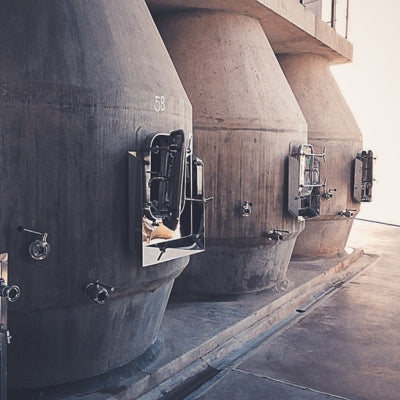
Alcoholic fermentation: vessels
In the second part of our article series on alcoholic fermentation, Westgarth Wines wine specialist Maurizio Broggi discusses the impact of fermentation vessels.
A wide range of vessels are used for fermentation. They vary in size, shape, and material which ultimately affect the temperature, rate, and outcome of alcoholic fermentation.
In red winemaking, fermentation occurs in contact with the skins to extract tannins, color, and flavors. Open-top fermenters allow access to the mass of grape skins (cap), provide oxygen for yeasts at the beginning of the fermentation, and provide easier dissipation of heat. Open-top fermenters are common and practical for small vessels, and they are often adopted in Burgundy for Pinot Noir. By contrast, white and rosé wines require reductive winemaking, i.e. minimal exposure to oxygen, to preserve fresh and fruity aromatics and avoid oxidation, hence the usage of closed fermentation vessels.
Stainless steel tanks
Nowadays, stainless steel tanks are the preferred vessels for most wines and are particularly essential for the styles of white and rosé wines. They can be manufactured in any size and have distinct several advantages, such as being easily suited to artificial temperature control, and ease of maintenance and cleaning. Stainless steel tanks do not impart any additional flavors to the wine, and as such allow the grapes to express themselves faithfully. Due to the precision engineering of these airtight tanks, oxidation is extremely controlled and precise.
Another key benefit of stainless steel is its longevity, with tanks offering a considerable lifespan. By comparison, oak barrels will typically last for up to five years before needing to be replaced due to the acidic deterioration of the wood fibers.
Wooden vats
Although many red wines are fermented in stainless steel tanks, some producers prefer wooden vats as they promote extraction from the skins. Some white wines, notably Chardonnay, are fermented in oak barrels. Oak barrels come in a wide range of sizes from the traditional small Burgundy pièce (228 liters) to larger, oval-shaped foudres in Alsace.
Fermentation in wooden vats allows some oxygen to work on the wine since wood is watertight, but not completely airtight. This generally results in a softer wine, and some woods, such as oak, also impart character at this stage, however as wood is a natural medium, it is often hard to control the ingress of oxygen making this process tricky.
Concrete vessels
Concrete, or cement, vessels were once very popular in the wine industry, and for a time looked as though they’d make wooden barrels obsolete due to several distinct advantages. However, they lacked elegance and were themselves overthrown by stainless steel. Some producers stuck with it, however, and today concrete is once again gaining traction. They are typically lined internally with glass or epoxy resin or treated with tartaric acid to provide an inert surface in contact with the wine. Due to the thickness of the material, they are excellent for maintaining a constant temperature.
Concrete eggs are a new wave of egg-shaped vessels that are becoming increasingly popular. Their egg shape is said to promote homogenization and even mixing of the fermenting wine.
While concrete allows for a neutral environment, it is also slightly porous, allowing some micro-oxygenation to take place. Concrete vessels are, however, somewhat bulky due to their thick walls, and must be carefully maintained.
Want to read more? Take a look at some of our other blogs:
Also in News

Collectors Corner: What will 2026 bring for fine wine?
Key themes likely to impact collecting decisions


